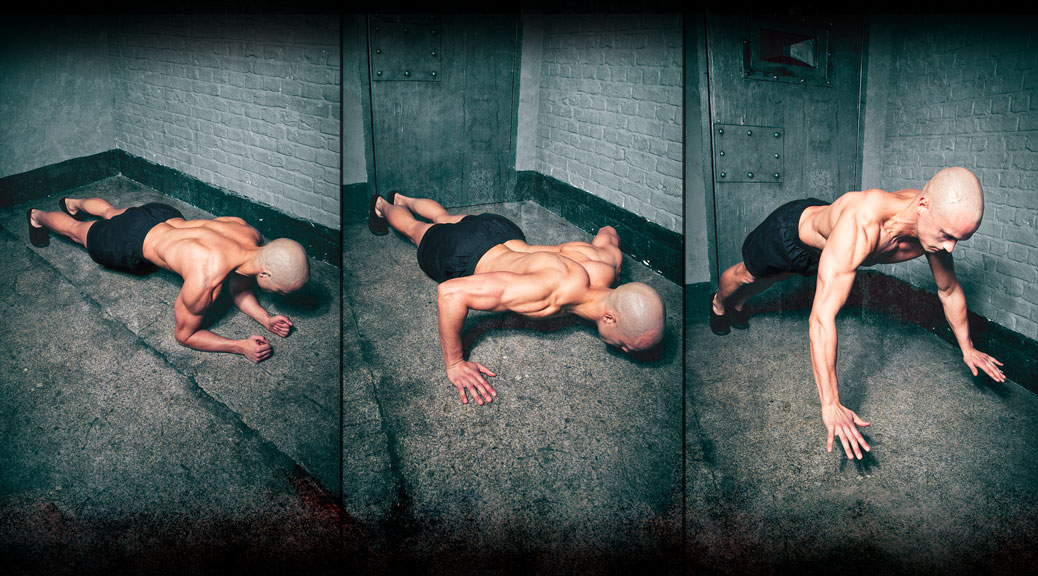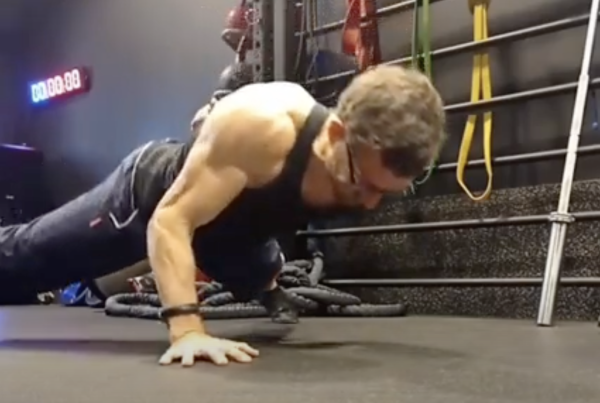Imagine being in lockdown for 22 hours a day at Pentonville Prison. Olivia Hubbard asks LJ Flanders about his Cell Workout, which helped to keep him occupied during his detention, and how he turned Cell Workout into a book that has already sold 3,000 copies, with a second volume and an e-book on the way.
Olivia Hubbard: What went through your mind when you started performing bodyweight exercises in your cell?
LJ Flanders: On my arrival at HMP Brixton, where I stayed for the first two weeks, I was banged up for 22 hours a day with no access to the gym. I was 21 and instantly felt the need to train as a way of release. I wasn’t a gym goer before prison, so I only knew the basic press-up and sit-up. My reps were various and sets were stagnated, with no concept of rest between sets because I didn’t have the basic knowledge of how to train.
It really was a case of going stir crazy and the exercises soon become tedious, offering no progression, so I started doing makeshift inverted rows on the underside of the bunk bed and dips off the pipes, not knowing the names of the exercises or the muscles I was using (and far from safe or practical). I was constantly thinking, “I need to get in the gym and hit the weights if I want to see a difference.”
I cherished my half hour in the yard and I remember doing laps from the very first day, then sprinting back for a quick wash before bang up. There is only a very small allocated time for being outside your cell and a lot to get done: phone calls, shower, food, etc. Even back then I remember thinking, “I need a book to help me learn how to train in my cell.”
OH: What would an average day look like?
LJF: At first, the stress really got to me and my weight plummeted, due to not having an appetite, so I had zero strength or energy. But, once I settled in and adapted to my new environment, I started to treat it like a normal day.
Prison is very structured and everything is done on the clock. In the early stages, the only chance I got to train was in my cell and running when out in the yard. But, when I got my job in the prison gym, I had more freedom and had the opportunity to use weights. My day-to-day routine was to do a short 7am cardio session or intervals to set me up for the day, back to my cell for a breakfast of oats, protein power and milk at 7:30am, 10:30am lunch consisting of whatever I chose from the multi-choice servery sheet, bang up, a 12pm weights session focusing on the muscle group for that day of my five-day split (leaving two days’ rest a week), another meal at 2pm of tuna and noodles, 4:30pm dinner, bang up, 7:30pm supper.
Having structure and being organised is key to success in all aspects of life but, on the outside, time is definitely not on our side with the busy lifestyles we tend to live.
OH: How did you view your time inside?
LJF: Some people may view it as having their life on hold but I saw it as an opportunity to develop. On the outside, with a 9-5 working day, we don’t have a lot of time to get creative – we use up all our energies through the day – and rightly so – feeling tired after dinner, which leaves no room to get the creative juices flowing. Inside, I was constantly planning my sentence and what I wanted to achieve in that time and upon release. I never rested on my laurels and stayed determined to stick to the goals I set myself. No matter how long your sentence, you have to plan for that amount of time, otherwise you can crumble. If I hit a lull during the day, I would do a 15-30-minute cardio session and benefit massively from the endorphins. Whatever was getting me down felt much more manageable after exercise.
OH: What advice did you give fellow inmates?
LJF: ‘Cell Workout’ is a generic term used among prison inmates but the requests for workouts made me realise that the concept wasn’t limited just to the prison population; the bodyweight principle appeals to everyone – even someone who works on a submarine bought a copy of my book as they said it was ideal for their environment and, more recently, I had the honour of meeting British astronaut Tim Peake. After looking through the book, he said it would be perfect for his time in space and he would take a copy on his next expedition. Not to mention HRH Prince Charles wanting to give a few press-ups a go after I presented him with a signed copy.
OH: Which of your skills have you come to rely on as you go about your personal training?
LJF: When I first got my job at Virgin Active two weeks after leaving prison it was a big learning curve, from helping the remedial inmates in HMP Pentonville to having my first day on the gym floor.
It was great building a rapport with my clients. A main aim was to teach them how to train to achieve their goals, without relying on me three or four times a week. Trying new training techniques and methods was an enjoyable learning process and something I wanted to further my studies in. I wanted my clients to realise what their goals were and how they needed to train and what to eat to achieve them.
I got to the point at Virgin where I was only helping one person for the hour, whereas I could help more people on a wider scale with the work I was doing with Cell Workout and the message I was trying to put out, which is that Cell Workout will give you the knowledge to help you improve your overall physical fitness.
OH: What’s been the response from individuals in prison who have used your book?
LJF: Some people have purchased the book before going into prison and used it as preparation and a lot of family and friends have sent the book in to loved ones, for which I have received many thanks. From my initial idea, the response has been overwhelmingly positive.
The feedback from prison staff, librarians, gym staff and education departments has also been very positive. For example, Neil Barclay, librarian and learning skills lead at HMP Thameside, has said, “As LJ is a former prisoner, I believe that a lot of prisoners inside are inspired by his devotion to in-cell exercise and he is encouraging many to get their lives back on track.”
OH: How did you switch off from your surroundings when performing meditative poses in prison?
LJF: I think I hit all three clichés during my time in prison: I got fit, wrote a book and found faith. Finding peace in Buddhism taught me to be more content and respect others. After going to the chapel every Friday for Buddhist meditation sessions I noticed the benefits of the class. I tend to be quite erratic, with thoughts jumping around, and I found the sessions really beneficial. Focusing the mind on the breathing helped to relieve built-up stress.
OH: Where are you coaching now?
LJF: My routine when I was at Virgin was training clients in the mornings, working on the book during the day and getting back to the gym for my evening clients. Now I keep a selection of clients in the evening and the majority of my time goes into my book and travelling around to various prisons to hold group workout sessions there. And also finding the time to train myself!
OH: What’s the future looking like for you?
LJF: Since releasing Cell Workout last year, my work with the prisons has grown, which has lead me to set up my community interest company Cell Workout Enterprise. This has enabled me to continue my work delivering fitness workshops in prisons around the country. I hope to eventually employ ex-offenders who have the desire to work in the fitness industry and an interest in prison reform, so they can help to deliver the courses in prisons around the country.
I have also been appointed as a Young Ambassador for the Prince’s Trust. Part of my role is to encourage young people to make positive changes to their lives.
OH: What did Pentonville teach you about yourself?
LJF: Firstly, appreciation. You don’t know what you have until it’s gone. Although it was four years ago now, it’s easy to forget but, if ever I’m having a bad day, I just have to think back to my time inside to realise how lucky I am to be where I am today. For me, going into prison was a life-changing experience that will live with me forever, for both good and bad. Everyone tells themselves, “I know I never want to come back here”, which is why I made sure I got a qualification while inside to give myself better job opportunities for when I left and I’ve continued to work hard since leaving to build a future for myself.
Making the mistake that sent me to prison is something I will always regret but it has sent me on a journey and I’m determined to make something positive come from it. I know that a lot of people in prison have taken inspiration from what I have achieved. Prison can be a bleak place but, no matter how down you are, I believe all is not lost. I was once where they are now and I hope I can make them think about what they want from their lives and their future and do something to make it better.
OH: And, finally, are you a FitPro member?!
LJF: I am now!
Visit cell-workout.com to find out more. All photographs credited to Drew Shearwood.









